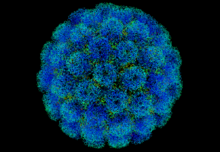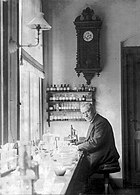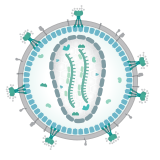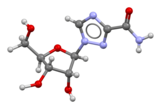
Back بوابة:علم الفيروسات Arabic Portail:Virologie French Portal:Virus ID Portal:Vírus Portuguese باب:وائرس Sindhi ද්වාරය:වෛරස Singhalese باب:وائرسز Urdu Portal:病毒 Chinese
The Viruses Portal
Welcome!

Viruses are small infectious agents that can replicate only inside the living cells of an organism. Viruses infect all forms of life, including animals, plants, fungi, bacteria and archaea. They are found in almost every ecosystem on Earth and are the most abundant type of biological entity, with millions of different types, although only about 6,000 viruses have been described in detail. Some viruses cause disease in humans, and others are responsible for economically important diseases of livestock and crops.
Virus particles (known as virions) consist of genetic material, which can be either DNA or RNA, wrapped in a protein coat called the capsid; some viruses also have an outer lipid envelope. The capsid can take simple helical or icosahedral forms, or more complex structures. The average virus is about 1/100 the size of the average bacterium, and most are too small to be seen directly with an optical microscope.
The origins of viruses are unclear: some may have evolved from plasmids, others from bacteria. Viruses are sometimes considered to be a life form, because they carry genetic material, reproduce and evolve through natural selection. However they lack key characteristics (such as cell structure) that are generally considered necessary to count as life. Because they possess some but not all such qualities, viruses have been described as "organisms at the edge of life".
Selected disease
Influenza, or flu, is an infectious disease caused by some orthomyxoviruses, that affects birds and some mammals including humans, horses and pigs. Influenza is predominantly transmitted through the air by coughs or sneezes, creating aerosols containing the virus. It can also be transmitted by contact with bird droppings or nasal secretions, or by touching contaminated surfaces. As the virus can be inactivated by soap, frequent hand washing reduces the risk of infection. Around a third of cases show no symptoms. The most common symptoms include fever, runny nose, sore throat, muscle pains, headache, cough and fatigue. Influenza is occasionally associated with nausea and vomiting, particularly in children. Pneumonia is a rare complication which can be life-threatening.
Influenza spreads around the world in seasonal epidemics, resulting in about 3–5 million cases of severe illness annually, and about 250,000–500,000 deaths, mainly in the young, the old and those with other health problems. Annual influenza vaccinations are recommended for those at high risk. Sporadic influenza pandemics have been recorded since at least the 16th century. The Spanish flu pandemic of 1918–20 is estimated to have killed 50–100 million people.
Selected image
The Varroa destructor mite can transmit viruses, including deformed wing virus, to its honey bee host. This might contribute to colony collapse disorder, in which worker bees abruptly disappear.
Credit: Eric Erbe & Christopher Pooley
In the news
26 February: In the ongoing pandemic of severe acute respiratory syndrome coronavirus 2 (SARS-CoV-2), more than 110 million confirmed cases, including 2.5 million deaths, have been documented globally since the outbreak began in December 2019. WHO
18 February: Seven asymptomatic cases of avian influenza A subtype H5N8, the first documented H5N8 cases in humans, are reported in Astrakhan Oblast, Russia, after more than 100,0000 hens died on a poultry farm in December. WHO
14 February: Seven cases of Ebola virus disease are reported in Gouécké, south-east Guinea. WHO
7 February: A case of Ebola virus disease is detected in North Kivu Province of the Democratic Republic of the Congo. WHO
4 February: An outbreak of Rift Valley fever is ongoing in Kenya, with 32 human cases, including 11 deaths, since the outbreak started in November. WHO
21 November: The US Food and Drug Administration (FDA) gives emergency-use authorisation to casirivimab/imdevimab, a combination monoclonal antibody (mAb) therapy for non-hospitalised people twelve years and over with mild-to-moderate COVID-19, after granting emergency-use authorisation to the single mAb bamlanivimab earlier in the month. FDA 1, 2
18 November: The outbreak of Ebola virus disease in Équateur Province, Democratic Republic of the Congo, which started in June, has been declared over; a total of 130 cases were recorded, with 55 deaths. UN
Selected article
The history of virology is usually considered to begin in the late 19th century, when the first evidence for the existence of viruses came from experiments using filters with pores small enough to retain bacteria. Dmitry Ivanovsky showed in 1892 that sap from a diseased tobacco plant remained infectious despite having been filtered; this agent, later known as tobacco mosaic virus, was the first virus to be demonstrated. In 1898, Friedrich Loeffler and Paul Frosch showed that foot-and-mouth, an animal disease, was caused by a filterable agent. That year, Martinus Beijerinck (pictured) called the filtered infectious substance a "virus" – often considered to mark the beginning of virology.
Bacteriophages, viruses that infect bacteria, were characterised by Frederick Twort and Félix d'Herelle in the early 20th century. In 1926, Thomas Milton Rivers defined viruses as obligate parasites. Viruses were demonstrated to be particles, rather than a fluid, by Wendell Meredith Stanley, and the invention of the electron microscope in 1931 allowed them to be visualised.
Selected outbreak
The West African Ebola epidemic was the most widespread outbreak of the disease to date. Beginning in Meliandou in southern Guinea in December 2013, it spread to adjacent Liberia and Sierra Leone, affecting the cities of Conakry and Monrovia, with minor outbreaks in Mali and Nigeria. Cases reached a peak in October 2014 and the epidemic was under control by late 2015, although occasional cases continued to occur into April 2016. Ring vaccination with the then-experimental vaccine rVSV-ZEBOV was trialled in Guinea.
More than 28,000 suspected cases were reported with more than 11,000 deaths; the case fatality rate was around 40% overall and around 58% in hospitalised patients. Early in the epidemic nearly 10% of the dead were healthcare workers. The outbreak left about 17,000 survivors, many of whom reported long-lasting post-recovery symptoms. Extreme poverty, dysfunctional healthcare systems, distrust of government after years of armed conflict, local burial customs of washing the body, the unprecedented spread of Ebola to densely populated cities, and the delay in response of several months all contributed to the failure to control the epidemic.
Selected quotation
| “ | There is no question that virology has long outgrown the confines of "Microbiology": it is an important discipline in its own right, a fact that is attested by the numerous high quality journals that are exclusively devoted to it. Further, it is primarily virology that has made possible the rapid rise of molecular cell biology. | ” |
—Bill Joklik on founding a society for virology
Recommended articles
Viruses & Subviral agents: bat virome • elephant endotheliotropic herpesvirus • HIV • introduction to viruses![]() • Playa de Oro virus • poliovirus • prion • rotavirus
• Playa de Oro virus • poliovirus • prion • rotavirus![]() • virus
• virus![]()
Diseases: colony collapse disorder • common cold • croup • dengue fever![]() • gastroenteritis • Guillain–Barré syndrome • hepatitis B • hepatitis C • hepatitis E • herpes simplex • HIV/AIDS • influenza
• gastroenteritis • Guillain–Barré syndrome • hepatitis B • hepatitis C • hepatitis E • herpes simplex • HIV/AIDS • influenza![]() • meningitis
• meningitis![]() • myxomatosis • polio
• myxomatosis • polio![]() • pneumonia • shingles • smallpox
• pneumonia • shingles • smallpox
Epidemiology & Interventions: 2007 Bernard Matthews H5N1 outbreak • Coalition for Epidemic Preparedness Innovations • Disease X • 2009 flu pandemic • HIV/AIDS in Malawi • polio vaccine • Spanish flu • West African Ebola virus epidemic
Virus–Host interactions: antibody • host • immune system![]() • parasitism • RNA interference
• parasitism • RNA interference![]()
Methodology: metagenomics
Social & Media: And the Band Played On • Contagion • "Flu Season" • Frank's Cock![]() • Race Against Time: Searching for Hope in AIDS-Ravaged Africa
• Race Against Time: Searching for Hope in AIDS-Ravaged Africa![]() • social history of viruses
• social history of viruses![]() • "Steve Burdick" • "The Time Is Now" • "What Lies Below"
• "Steve Burdick" • "The Time Is Now" • "What Lies Below"
People: Brownie Mary • Macfarlane Burnet![]() • Bobbi Campbell • Aniru Conteh • people with hepatitis C
• Bobbi Campbell • Aniru Conteh • people with hepatitis C![]() • HIV-positive people
• HIV-positive people![]() • Bette Korber • Henrietta Lacks • Linda Laubenstein • Barbara McClintock
• Bette Korber • Henrietta Lacks • Linda Laubenstein • Barbara McClintock![]() • poliomyelitis survivors
• poliomyelitis survivors![]() • Joseph Sonnabend • Eli Todd • Ryan White
• Joseph Sonnabend • Eli Todd • Ryan White![]()
Selected virus
Human immunodeficiency virus (HIV) is a lentivirus, an RNA virus in the retrovirus family. Two types of HIV have been characterised: HIV-1 is the more virulent and is responsible for most infections worldwide; HIV-2 is mainly confined to West Africa. The genome consists of two copies of a single-stranded +RNA, which contains nine genes. The roughly spherical virus particle has a diameter of about 120 nm; it is enveloped and contains a conical capsid made of around 2,000 copies of the p24 protein. The envelope glycoprotein, a trimeric complex of gp120 and gp41, binds to CD4, the primary receptor on the host cell.
Transmission occurs by the transfer of bodily fluids including blood, semen, vaginal fluids and breast milk, in which the virus is present both as free virus particles and within infected immune cells. HIV infects key cells in the human immune system including CD4+ T helper cells, macrophages and dendritic cells. Infection leads to low levels of CD4+ T cells via several mechanisms, resulting in a progressive immunodeficiency disease known as AIDS.
Did you know?
- ...that Franquet's Epauletted Fruit Bat (pictured) is one of three fruit-eating bats found to be a reservoir for Ebola virus in the wild?
- ...that 95% of adults have been infected by human herpesvirus 7, a virus that can cause influenza-like illness and seizures but normally causes no symptoms?
- ...that James Jurin used statistical studies to show the probability of death from smallpox vaccine was significantly less than from smallpox?
- ...that the log-Cauchy distribution has been proposed as a model for the progression of HIV in individuals?
- ...that Corona, named after Corona, is fighting corona?
Selected biography
Ali Maow Maalin (1954 – 22 July 2013) was a hospital cook and health worker from Merca, Somalia, who is the last person in the world known to be infected with naturally occurring smallpox. Although he worked in the local smallpox eradication programme, he had not been successfully vaccinated. In October 1977, he was infected with the Variola minor strain of the virus while driving two children with smallpox symptoms to quarantine. He did not experience complications and made a full recovery. An aggressive containment campaign was successful in preventing an outbreak, and smallpox was declared to have been eradicated globally by the World Health Organization (WHO) two years later.
In later life, Maalin volunteered for the successful poliomyelitis eradication campaign in Somalia. He worked for WHO as a local coordinator with responsibility for social mobilisation, and spent several years travelling across Somalia, vaccinating children and educating communities. He encouraged people to be vaccinated by sharing his experiences with smallpox. He died of malaria while carrying out polio vaccinations after the reintroduction of poliovirus to the country in 2013.
In this month
March 1990: Proposal for a database of all viruses, later the ICTVdB
3 March 2014: Discovery of Pithovirus sibericum, the largest known virus at 1.5 μm long by 0.5 μm in diameter
4 March 1918: First case reported in the 1918 influenza pandemic
10 March 1956: Francis Crick and James Watson proposed that small viruses have a protein shell consisting of a large number of identical subunits
10 March 1956: Donald Caspar published paper on the structure of tomato bushy stunt virus
13 March 2003: Enfuvirtide (T20) approved; first HIV fusion inhibitor, also first HIV entry inhibitor
20 March 1987: Antiretroviral drug AZT (pictured) became the first antiviral medication approved for use against HIV/AIDS
22 March 2014: First case reported in the West African Ebola outbreak, the most widespread so far
26 March 1953: Jonas Salk reported a successful test of an inactivated polio vaccine.
28 March 2003: Mimivirus shown to be a virus, then the largest known
Selected intervention
Ribavirin is a nucleoside analogue that mimics the nucleoside guanosine. It shows some activity against a broad range of DNA and RNA viruses, but is less effective against dengue fever, yellow fever and other flaviviruses. The drug was first synthesised in the early 1970s by Joseph T. Witkowski and Roland K. Robins. Ribavirin's main current use is against hepatitis C, in combination with pegylated interferon, nucleotide analogues and protease inhibitors. It has been used in the past in an aerosol formulation against respiratory syncytial virus-related diseases in children. Ribavirin has been used in combination as part of an experimental treatment for rabies. It is also the only available treatment for the viruses causing some viral haemorrhagic fevers, including Lassa fever, Crimean–Congo haemorrhagic fever and hantavirus disease, but is ineffective against the filovirus diseases, Ebola and Marburg. Clinical use is limited by the drug building up in red blood cells to cause haemolytic anaemia.
Subcategories
Subcategories of virology:
Topics
Things to do
- Comment on what you like and dislike about this portal
- Join the Viruses WikiProject
- Tag articles on viruses and virology with the project banner by adding {{WikiProject Viruses}} to the talk page
- Assess unassessed articles against the project standards
- Create requested pages: red-linked viruses | red-linked virus genera
- Expand a virus stub into a full article, adding images, citations, references and taxoboxes, following the project guidelines
- Create a new article (or expand an old one 5-fold) and nominate it for the main page Did You Know? section
- Improve a B-class article and nominate it for Good Article
 or Featured Article
or Featured Article status
status - Suggest articles, pictures, interesting facts, events and news to be featured here on the portal
WikiProjects & Portals
 WikiProject Viruses
Related WikiProjects
WikiProject Viruses
Related WikiProjects
Medicine • Microbiology • Molecular & Cellular Biology • Veterinary Medicine
Related PortalsAssociated Wikimedia
The following Wikimedia Foundation sister projects provide more on this subject:
-
Commons
Free media repository -
Wikibooks
Free textbooks and manuals -
Wikidata
Free knowledge base -
Wikinews
Free-content news -
Wikiquote
Collection of quotations -
Wikisource
Free-content library -
Wikispecies
Directory of species -
Wikiversity
Free learning tools -
Wiktionary
Dictionary and thesaurus

















